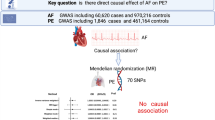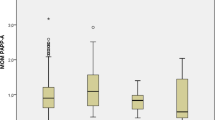Abstract
Pre-eclampsia (PE) is a disorder that occurs only during pregnancy. PE is associated with neonate mortality and morbidity. Overexpression of IL-27 and its receptor have been reported frequently in the trophoblast cells of patients with PE. In this study, we aimed to evaluate the relationship between genetic polymorphisms of IL-27 rs153109, and rs17855750 in an Iranian cohort of 170 PE patients and 170 normal pregnant women using the PCR-RFLP method. In the total PE, the frequency of heterozygous and mutant homozygous genotypes of rs153109 was significantly higher, severe, and mild PE groups. The genotypes and alleles frequencies of rs17855750 gene polymorphism were associated with PE susceptibility in total, severe and early-onset sub-group patients. Haplotype analysis of IL-27 rs153109 and rs17855750 polymorphisms revealed that the mutant GG haplotype frequencies significantly increased the risk of preeclampsia in total PE and different sub-group patients, while the wild AT haplotypes were associated with decreased risk of pre-eclampsia in total and sub-group patients. The in-silico analysis showed the transition of allele A to allele G in rs153109 SNP, would lead to create a new binding site and consequently may lead to changes in IL-27 gene expression. We found that rs17855750 A>G polymorphism might be influence the function of IL-27 protein. The data attained in our study propose the incidence of IL-27rs153109 and rs17855750 SNPs might be capable to be utilized as indicators for the genetic susceptibility to PE.





Similar content being viewed by others
Abbreviations
- PE:
-
Preeclampsia
- IL:
-
Interleukin
- TNF-α:
-
Tumor necrosis factor alpha
- IFN-γ:
-
Interferon gamma
- Th1:
-
T helper type 1
- Th2:
-
T helper type 2
- EBI3:
-
Epstein-barr virus induced 3
- TGF-β1:
-
Transforming growth factor beta 1
- PCR:
-
Polymerase chain reaction
- RFLP:
-
Restriction fragment length polymorphism
- ICAM-1:
-
Intercellular adhesion molecule 1
- VCAM-1:
-
Vascular cell adhesion molecule 1
- FGR:
-
Fetal growth restriction
References
Redman CW, Sargent IL (2005) Latest advances in understanding preeclampsia. Science 308:1592–1594
Practice ACoO (2002) ACOG practice bulletin. Diagnosis and management of preeclampsia and eclampsia. Number 33, January 2002. American college of obstetricians and gynecologists. Int J Gynaecol Obstet 77:67
Steegers EA, Von Dadelszen P, Duvekot JJ, Pijnenborg R (2010) Pre-eclampsia. Lancet 376:631–644
Al-Jameil N, Khan FA, Khan MF, Tabassum H (2014) A brief overview of preeclampsia. J Clin Med Res 6:1
Molvarec A, Szarka A, Walentin S, Szűcs E, Nagy B, Rigó J Jr (2010) Circulating angiogenic factors determined by electrochemiluminescence immunoassay in relation to the clinical features and laboratory parameters in women with pre-eclampsia. Hypertens Res 33:892
Redman C, Sargent I (2003) Pre-eclampsia, the placenta and the maternal systemic inflammatory response—a review. Placenta 24:S21–S27
Hill J, Choi B (2000) Maternal immunological aspects of pregnancy success and failure. J Reprod Fertil Suppl 55:91–97
Makhseed M, Raghupathy R, Azizieh F, Omu A, Al-Shamali E, Ashkanani L (2001) Th1 and Th2 cytokine profiles in recurrent aborters with successful pregnancy and with subsequent abortions. Hum Reprod 16:2219–2226
Aluvihare VR, Kallikourdis M, Betz AG (2004) Regulatory T cells mediate maternal tolerance to the fetus. Nat Immunol 5:266
Zenclussen AC, Gerlof K, Zenclussen ML, Sollwedel A, Bertoja AZ, Ritter T et al (2005) Abnormal T-cell reactivity against paternal antigens in spontaneous abortion: adoptive transfer of pregnancy-induced CD4+ CD25+ T regulatory cells prevents fetal rejection in a murine abortion model. Am J Pathol 166:811–822
Saito S, Nakashima A, Shima T, Ito M (2010) Th1/Th2/Th17 and regulatory T-cell paradigm in pregnancy. Am J Reprod Immunol 63:601–610
Darmochwal-Kolarz D, Kludka-Sternik M, Tabarkiewicz J, Kolarz B, Rolinski J, Leszczynska-Gorzelak B et al (2012) The predominance of Th17 lymphocytes and decreased number and function of Treg cells in preeclampsia. J Reprod Immunol 93:75–81
Deng Z, Zhang L, Tang Q, Xu Y, Liu S, Li H (2020) Circulating levels of IFN-γ, IL-1, IL-17 and IL-22 in pre-eclampsia: a systematic review and meta-analysis. Eur J Obstet Gynecol Reprod Biol 248:211–221
Bellos I, Karageorgiou V, Kapnias D, Karamanli KE, Siristatidis C (2020) The role of interleukins in preeclampsia: a comprehensive review. Am J Reprod Immunol 80(6):e13055
Yoshida H, Nakaya M, Miyazaki Y (2009) Interleukin 27: a double-edged sword for offense and defense. J Leukoc Biol 86:1295–1303
Villarino AV, Huang E, Hunter CA (2004) Understanding the pro-and anti-inflammatory properties of IL-27. J Immunol 173:715–720
Yin N, Zhang H, Luo X, Ding Y, Xiao X, Liu X et al (2014) IL-27 activates human trophoblasts to express IP-10 and IL-6: implications in the immunopathophysiology of preeclampsia. Mediators inflamm. https://doi.org/10.1155/2014/926875
de Lima THB, Sass N, Mattar R, Moron AF, Torloni MR, Franchim CS et al (2009) Cytokine gene polymorphisms in preeclampsia and eclampsia. Hypertens Res 32:565
Daher S, Sass N, Oliveira LG, Mattar R (2006) Cytokine genotyping in preeclampsia. Am J Reprod Immunol 55:130–135
Stonek F, Hafner E, Metzenbauer M, Katharina S, Stümpflen I, Schneeberger C et al (2008) Absence of an association of tumor necrosis factor (TNF)-alpha G308A, interleukin-6 (IL-6) G174C and interleukin-10 (IL-10) G1082A polymorphism in women with preeclampsia. J Reprod Immunol 77:85–90
Jahantigh D, Forghani F, Zidanloo SG (2019) Interleukin-23 receptor (IL-23R) gene polymorphisms and haplotypes associated with the risk of preeclampsia: evidence from cross-sectional and in silico studies. J Assist Reprod genet. https://doi.org/10.1007/s10815-019-01479-w
Jahantigh D, Mousavi M, Forghani F, Javan MR, Movahedinia S, Rezaei M (2018) Association between maternal circulating IL-27 levels and preeclampsia. Cytokine 102:163–167
Jahantigh D, Colagar AH, Salimi S (2017) Genetic polymorphisms and haplotypes of the DJ-1 gene promoter associated with the susceptibility to male infertility. J Assist Reprod Genet 34:1673–1682
Warde-Farley D, Donaldson SL, Comes O, Zuberi K, Badrawi R, Chao P et al (2010) The GeneMANIA prediction server: biological network integration for gene prioritization and predicting gene function. Nucleic Acids Res 38:W214–W220
Jahantigh D, Hosseinzadeh Colagar A (6721G) XRCC5 VNTR, XRCC6–61C> G, and XRCC7 6721G> T gene polymorphisms associated with male infertility risk: evidences from case-control and in silico studies. Int J Endocrinol. https://doi.org/10.1155/2017/4795076
Salimi S, Keshavarzi F, Mohammadpour-Gharehbagh A, Moodi M, Mousavi M, Karimian M et al (2017) Polymorphisms of the folate metabolizing enzymes: association with SLE susceptibility and in silico analysis. Gene 637:161–172
Aftabi Y, Colagar AH, Mehrnejad F (2016) An in silico approach to investigate the source of the controversial interpretations about the phenotypic results of the human AhR-gene G1661A polymorphism. J Theor Biol 393:1–15
Yong Y, Lin H (2005) SHEsis, a powerful software platform for analyses of linkage disequilibrium, haplotype construction, and genetic association at polymorphism loci. Cell Res 15:97
Liang Y, Sun R, Li L, Yuan F, Liang W, Wang L et al (2015) A functional polymorphism in the promoter of MiR-143/145 is associated with the risk of cervical squamous cell carcinoma in chinese women: a case-control study. Medicine. https://doi.org/10.1097/MD.0000000000001289
Chen P, Sun R, Pu Y, Bai P, Yuan F, Liang Y et al (2015) Pri-miR-34b/C and Tp-53 polymorphisms are associated with the susceptibility of papillary thyroid carcinoma: a case–control study. Medicine. https://doi.org/10.1097/MD.0000000000001536
Perez-Sepulveda A, Torres MJ, Khoury M, Illanes SE (2014) Innate immune system and preeclampsia. Front Immunol 5:244
Saito S, Shiozaki A, Nakashima A, Sakai M, Sasaki Y (2007) The role of the immune system in preeclampsia. Mol Aspects Med 28:192–209
Saito S, Sakai M (2003) Th1/Th2 balance in preeclampsia. J Reprod Immunol 59:161–173
Darmochwał-Kolarz D, Oleszczuk J (2014) The critical role of Th17 cells, treg cells and co-stimulatory molecules in the development of pre-eclampsia. Dev Period Med 18:141–147
Ohkura N, Sakaguchi S (2010) Regulatory T cells: roles of T cell receptor for their development and function. Semin Immunopathol 32:95–106
Kim S-Y, Ryu H-M, Yang JH, Kim M-Y, Ahn H-K, Lim H-J et al (2004) Maternal serum levels of VCAM-1, ICAM-1 and E-selectin in preeclampsia. J Korean Med Sci 19:688–692
Segerer S, Nelson PJ, Schlondorff D (2000) Chemokines, chemokine receptors, and renal disease: from basic science to pathophysiologic and therapeutic studies. J Am Soc Nephrol 11:152–176
Wuthrich RP, Snyder TL (1992) Vascular cell adhesion molecule-1 (VCAM-1) expression in murine lupus nephritis. Kidney Int 42:903–914
Liu J, Guan X, Ma X (2007) Regulation of IL-27 p28 gene expression in macrophages through MyD88-and interferon-γ–mediated pathways. J Exp Med 204:141–152
Owaki T, Asakawa M, Morishima N, Hata K, Fukai F, Matsui M et al (2005) A role for IL-27 in early regulation of Th1 differentiation. J Immunol 175:2191–2200
Liu B, Li Y, Yao Y, Li H, Liang H, Xin M et al (2016) Polymorphisms of the IL27 gene in a chinese Han population complicated with pre-eclampsia. Sci Rep 6:23029
Chen P, Gong Y, Pu Y, Wang Y, Zhou B, Song Y et al (2016) Association between polymorphisms in IL-27 gene and pre-eclampsia. Placenta 37:61–64
Borzychowski AM, Croy BA, Chan WL, Redman CW, Sargent IL (2005) Changes in systemic type 1 and type 2 immunity in normal pregnancy and pre-eclampsia may be mediated by natural killer cells. Eur J Immunol 35:3054–3063
Saini V, Arora S, Yadav A, Bhattacharjee J (2011) Cytokines in recurrent pregnancy loss. Clin Chim Acta 412:702–708
Coussons-Read ME, Mazzeo RS, Whitford MH, Schmitt M, Moore LG, Zamudio S (2002) High altitude residence during pregnancy alters cytokine and catecholamine levels. Am J Reprod Immunol 48:344–354
Filtz TM, Vogel WK, Leid M (2014) Regulation of transcription factor activity by interconnected post-translational modifications. Trends Pharmacol Sci 35:76–85
Acknowledgements
This study supported by Grant number 171/94 (Zbmu.1.REC.1396.25) from the Zabol University of Medical Sciences. The authors also would like sincerely thanks of all those who voluntarily have participated in this study.
Author information
Authors and Affiliations
Corresponding authors
Ethics declarations
Conflicts of interest
The authors declare that there are no conflicts of interest.
Additional information
Publisher's Note
Springer Nature remains neutral with regard to jurisdictional claims in published maps and institutional affiliations.
Electronic supplementary material
Below is the link to the electronic supplementary material.



Rights and permissions
About this article
Cite this article
Jahantigh, D., Ghazaey Zidanloo, S., Forghani, F. et al. IL-27 variants might be genetic risk factors for preeclampsia: based on genetic polymorphisms, haplotypes and in silico approach. Mol Biol Rep 47, 7929–7940 (2020). https://doi.org/10.1007/s11033-020-05871-z
Received:
Accepted:
Published:
Issue Date:
DOI: https://doi.org/10.1007/s11033-020-05871-z




